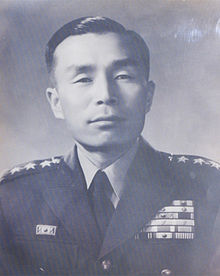Kim Jong-oh
Kim Jong-oh | |
|---|---|
 | |
| Born | 22 May 1921 Chūseihoku-dō, Korea, Empire of Japan |
| Died | 30 March 1966 (aged 44) |
| Allegiance | |
| Service | |
| Commands | 6th Infantry Division 9th Infantry Division I Corps |
| Battles / wars | |
| Alma mater | Chuo University |
Kim Jong-oh (Korean: 김종오; 22 May 1921 – 30 March 1966) was a South Korean army colonel and general in the Korean War. He was active in the First Republic of Korea and Third Republic of Korea. He was the 10th president of the Republic of Korea Military Academy (1952–1954) and commander of the Republic of Korea 1st Army.
Early life
[edit]Kim Jong-oh was born on 22 May 1921, in Chūseihoku-dō, Korea, Empire of Japan (now (North Chungcheong Province), South Korea). He went to Chuo University to study law in order to help Koreans.[1]
Military career
[edit]In 1944, he was conscripted in the Imperial Japanese Army while he was attending Chuo University. He was appointed as Second lieutenant. After the Empire of Japan surrendered, Kim came back to Korea. In 1946, he became Second lieutenant (Service Number 10031[1]) of the Korean Army. The next year, he became Lieutenant Colonel. In 1949, he became a Colonel. As the commander of 1st Brigade, he brought victory against the North Korean Army before the Korean War.[2][3]
At the outbreak of the Korean War, he commanded the 6th Infantry Division. He delayed the advance of the North Korean Army for 5 days. In Eumseong County, Kim attacked the 48th Brigade of North Korea. His division killed thousand of men and captured 97 men. For this, Kim was promoted to Brigade General. In September 1950, his division participated The Great Naktong Offensive. But during the offensive, Kim was injured and appointed as commander of 9th Infantry Division. But he was brought back to the headquarters later. In 1952, he was appointed as the commander of 9th Infantry Division and participated in Battle of White Horse Hill.[2] For 10 days, his division defended the White Horse Hill against three Chinese divisions under 35th Army Corps of China. His division finally made the Chinese Army to retreat.[4]
After the Korean Armistice, Kim was appointed as commander of I Corps. Later he became Chairman of the Joint Chiefs of Staff, and Chief of Staff. In 1962, he became Daejang, and he retired from the army in 1965.[2] On March 30, 1966, Kim died of lung cancer. His funeral was proceeded in the army headquarters in a Buddhist ritual.[5]
Bibliography
[edit]- 佐々木春隆 (1979). 朝鮮戦争/韓国篇 上・中・下巻. 原書房.
- 白善燁 (2000). 若き将軍の朝鮮戦争. 草思社. ISBN 4-79-420974-6.
- 韓国国防軍史研究所 編著 (2001). 韓国戦争 第2巻. Translated by 翻訳・編集委員会. かや書房. ISBN 4-90-612445-3.
- 韓国国防軍史研究所 編著 (2004). 韓国戦争 第4巻. Translated by 翻訳・編集委員会. かや書房. ISBN 4-90-612458-5.
- 韓国国防軍史研究所 編著 (2010). 韓国戦争 第6巻. Translated by 翻訳・編集委員会. かや書房. ISBN 978-4-90-612469-5.
References
[edit]- ^ a b Ministry of National Defense (South Korea). "[6· 25전쟁의 명장] 백마고지 전투를 승리로 이끈 '김종오 장군'". Naver Blog | 국방부 블로그 (in Korean). Retrieved 2022-03-04.
- ^ a b c "김종오(金鍾五)". Encyclopedia of Korean Culture. Retrieved 2022-03-04.
- ^ ""백마고지 전투 영웅 '김종오 장군' 계승해야"". 세종의소리 (in Korean). 2016-04-29. Retrieved 2022-03-04.
- ^ "[6·25 결정적 전투들] ⑨ 백마고지전투". www.korea.kr (in Korean). Retrieved 2022-03-04.
- ^ "김종오 장군 3일 육군장". JoongAng Ilbo (in Korean). 1966-03-30. Retrieved 2022-03-04.
- 1921 births
- 1966 deaths
- People from North Chungcheong Province
- Republic of Korea Army personnel
- Korean collaborators with Imperial Japan
- South Korean military personnel of the Korean War
- Chiefs of staff of the Army (South Korea)
- Chairmen of the Joint Chiefs of Staff (South Korea)
- Deaths from lung cancer in South Korea
- Gimhae Kim clan
- South Korean Roman Catholics
- Imperial Japanese Army personnel of World War II
- Burials at Seoul National Cemetery
